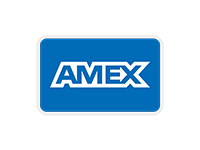GM New Look Master Class


Typical of the GM Old Look line-up is TTC 1955, a TDH-4512 model dating from 1956. These post-war buses were solid, dependable and enjoyed tremendous success but it is easy to see how refreshingly bright and open the New Look was in comparison. Unknown photographer A.Zhelka Collection
The New Look Bus
When looking at any image of a North American urban streetscape from the 1960s, 70s or the 80s, chances are good that a GM New Look bus is visible. They were that successful.
For almost six decades, General Motors was the leading bus builder on this side of the ocean. From its origins as majority owner of the Yellow Truck & Coach Manufacturing Company (Yellow Coach) commencing in 1925, GM quickly established itself as a serious contender in the bus field. By buying out several smaller companies, the company was able to adopt the latest technology of the day to build innovative, rugged and reliable vehicles. Chief among these evolutionary milestones was the introduction of the rear-engined coach in 1934 which incorporated an angle drive transmission. However, Yellow Coach continued to offer front-engined models and a variety of other configurations in several sizes and capacities. Although there were many competitor builders in those early decades, the GM bus was always among the top sellers of that time by offering different models to suit customer needs.
Commencing in 1940, the GM transit bus design was evolving to a more familiar form which incorporated all of the best practices developed to that point – that being the traditional rear-engined, vehicle which was available in several different lengths. The modular type construction allowed for a variety of configurations by adding or subtracting window and door sections, and the engineered steel framing and the outer sheet metal increased strength while reducing weight by eliminating heavy structural members. Standard engine power was now from the famed GM 71-series diesel engine, which quickly became legendary for its reliability and robust performance. The Yellow Coach identity was discarded in 1943 when GM bought out the remaining ownership of its former partnership and consolidated bus construction under its new GMC Truck & Coach Division. Other improvements such as air ride suspension, reliable automatic transmissions and air conditioning would be added in the coming years winning over passengers and operators alike.
Other bus manufacturers still shared the field of course, and some of them enjoyed a measure of success, especially in those immediate post-war years when buses were in short supply as most cities abandoned their streetcars. But in time, these other companies began to disappear as the bus industry consolidated on a few key builders. Indeed, such was the case that by the mid 1950s, the US federal government launched an investigation to determine if there was collusion by GM to create a monopoly of the bus industry. Perhaps fearing the giant company might be broken up, GM readily agreed to the ‘Consent Decree’ which dictated that it supply many of its successful components and patents to other bus manufacturers (at prices equivalent to those paid by GM Truck & Coach) to enable the competition to succeed. Oddly, although this satisfied immediate concerns, in many ways it only further served to cement the dominance of various GM components such as the Detroit Diesel engine.
Despite the obligations of the Consent Decree to promote renewed competition, GM’s ambitious sales force continued to push to maintain their lead in the bus industry. In considering future trends, it was obvious that GM anticipated the coming evolution of the city landscape and the necessary changes to serve that market. Suburban growth was exploding, the daily commute was evolving and the private car had transitioned from a simple conveyance to a symbol of fashion, status and necessity for these new bedroom communities. Indeed, much of this change had been facilitated by General Motors itself, as well as the other major car manufacturers of the day. The negative effect of this on the traditional population centres was quickly becoming apparent and suddenly urban transit was looking tired and old fashioned while the roads were increasingly congested. The capable GM engineering staff took note and in 1956, began to consider the needed improvements that should go into the next generation of transit bus. Ironically, if there had been concerns about GM’s dominance in the bus industry, this total redesign of the urban bus would reshape the look of public transit for generations.
The GM New Look
The updated design was formerly announced in January 1959 and was called the New Look Bus. Although not the intent, the familiar squared-windowed, flat skinned, post-war GM design immediately became known as the Old Look bus by default. But the difference between the two models was enormous as almost every aspect of the vehicle had been redesigned. Gone was the old boxy design with its many small windows and dark interior, replaced instead with a streamlined bus of bright anodized aluminum and large swaths of glass, moulded to highlight the curves of the bodywork.
Early sales literature featured illustrations of the new bus but by mid-year, pre-production prototypes were being displayed at industry trade shows giving eager customers a first-hand look.
The aesthetics of this modern transit bus were not introduced at once but appear to have evolved from other GM projects of the 1950s. One was the very popular GM highway coach, the PD-4104 (1953) which became one of the most widely sold coaches of all time. Another was the futuristic GM Aerotrain (1955), an experimental lightweight train which adapted GM highway coach bodies for use as passenger railcars. Both of these vehicles featured side parallelogram passenger windows, polished fluted side panels, riveted monocoque construction and large expanses of curved glass. Decorative trim and lighting details prominent on the GM automobiles of the era were also adopted. Thus, in early 1959 when GM released images of their proposed new transit bus, it reflected an up to date, contemporary vision that the public had come to expect of that modern era.
The exterior featured large trapezoid windows, polished fluted panelling, pleasing curves and custom body panels. By far, the most notable feature was the massive six piece windshield which gave the vehicle a light, welcoming appearance and would soon give rise to its unofficial ‘fishbowl’ name. The narrow bi-fold front doors of the Old Look were now replaced with a new two-piece ‘slide-glide’ design which also featured larger windows and better viewing for both passengers and operators. The interior was also equally transformed and passenger comfort was carefully considered. The larger glass area brightened the passenger cabin as did the metallic wall sheathing and light coloured ceiling panels. Night time riders were treated to new fluorescent lighting which bathed the interior in a uniform glow. This was said to better detect tripping hazards at floor level and enable commuters the opportunity to read.
GM’s marketing department worked closely with the customer to show the new buses to their best advantage. Exterior surfaces above the belt rail, as well as the top and front of the bus required painting, and a company’s livery was carefully applied to highlight the New Look’s unique shape. This attention extended into the interior of the bus where a host of pastel colour selections were offered so that all painted surfaces complimented the exterior. To maintain the theme, seat coverings were typically done in a two tone vinyl which often mimicked the exterior livery. Even the light coloured ceiling melamine panels had options (including the familiar ‘starburst’ pattern). Heating was thermostatically controlled and was provided by large under floor blowers which pushed warm air up through the inside of the lower wall providing uniform climate control throughout. The front dash had a separate heating / blower system which had to be powerful enough to cover the large expanse of the front windshield area. Air conditioning was a factory option and when installed, the a/c unit was blended into the roofline above the rear window but was distributed via the heating ventilation ducts.
Operator comfort was equally important and a spacious driver’s area with a simple dash and GREAT sightlines were standard. A 30 inch wide entrance way with three steps from ground level brought passengers up to the front aisle. At this location, next to the driver, allowances were made for a variety of configurations here, depending on system requirements. Stanchion placement, farebox location, ticketing and change equipment could vary. As well, additional lighting, defrost fans, tachometers, radio and PA equipment, sign brackets and run sign boxes were among the various accessories which may have been installed on the front dash and noticed by the passenger when boarding the bus.
For the mechanic, the bus also had much to offer. The power plant was the proven and familiar 71-series diesel engine which had been reconfigured from an inline style into a V design for the New Look - these models being designated 6V-71 or 8V-71, depending on number of cylinders. Engine placement was transverse across the rear of the bus with the standard angle drive transmission arrangement. This new V-style engine was readily accessible on three sides but by mounting it on an rearward leaning angle, the side up against the rear bulkhead could be reached. Other mechanical accessories were spread throughout the vehicle, mostly accessible from the underside. Some were familiar Old Look components while others were newly designed for the New Look.
As noted, the bus body structure continued with the monocoque type construction, which was chosen for its economical and lightweight properties. The frame was made from a combination of steel and aluminum members onto which an outer skin was riveted (solid aluminum rivets) providing both strength and stiffness to the vehicle. Bright polished aluminum fluted side panels were used below the belt rail while the belt rail itself was flat polished aluminum (at least on first generation New Looks) Above this were the side window frame panels which were painted steel as were the front and back stampings around the window and destination sign. The roof panels themselves were also aluminum, but were painted. Side to side underfloor bulkheads supported the plywood floor as well as providing structural support for the engine, axles and air suspension components.
The extensive use of rivets and ready access to structural components of the body made the GM buses easy to repair. Collision damaged buses could have their damaged panels and framing quickly replaced enabling minimum downtime. As well, over time as the buses as the buses aged, this type of construction made vehicle refurbishment a practical and economical alternative permitting many New Looks buses to serve well beyond the typical 15-18 year lifespan. Indeed, there were many cases of New Look buses operating in service for 30 years or more! Special care was given to reducing oxidation where steel and aluminum came into contact but over time, aluminum corrosion could occur at these key locations. It has been noted that many of the above features did appear on other competitor buses, but certainly the GM New Look was the first to bring them all together (as well as many more improvements) in a single, smart looking vehicle.
New Look Production Begins
Old Look production continued at Pontiac, Michigan for the first half of 1959 after which the line was shut down and switched over to building the New Look bus. The very first units (TDH-5301 – 001 & 002) were set aside as sales demonstrators. Actual customer units followed right after with the first buses departing the plant in September 1959 for delivery to Washington D.C. Thus the first New Looks were introduced in pomp & ceremony to an excited public on September 24th, 1959 in a celebration which is said to have included a 115 vehicle parade of new and vintage buses which extended over a mile! The Cleveland Transit system had their launch the following day (September 25th) while New York City (The Fifth Ave Bus Company) presented their Bus of the Future to the Mayor and delegates on October 2nd.
Public response was immediate and again, the GM Marketing department was on hand to assist with the vehicle launches including promotional material and photo opportunities, all to highlight the new era in public transit. In many regards, the launch of the New Look bus copied the successful inauguration of the PCC streetcar a generation earlier. New Look vehicles were promoted and celebrated with catchy names such as Dreamliner, Dandiliner or Crystal Liner and passenger numbers carefully tracked to confirm ridership increases.
In Canada, a New Look was first shown at an industry convention in November 1959 which was held in Fort William, home-town of Canadian Car & Foundry, which was Canada’s largest bus builder at that time. The Toronto Transit Commission was this country’s first New Look customer with 50 53-passenger units delivered in December 1959 – January 1960. Revenue operation began early in 1960.
The bus proved to be an adaptable platform and both suburban and transit models were offered in many configurations to satisfy a variety of needs. Operators could choose between a 35 or 40 foot bus, available in either a 96 inch or 102 inch width. Local needs as well as state or provincial rules dictated what lengths or widths were allowed on local roads and highways. Air conditioning, double or single rear exit doors and other features remained as options. As well, GM would sometimes make custom changes as dictated by the customer. The elimination of standee windows on later TTC transit buses, or the Boston 35 foot transits with double-stream exit doors and a unique window arrangement were examples of this.
Although the New Look bus was now the most identifiable product of their bus line up, intercity highway coaches (historically referred to as Parlour coaches) were still offered as before, however some of this market was now absorbed by New Look buses built for highway use. These ‘Suburban’ model units featured high back seats, underfloor luggage bays, air conditioning, the larger 8V-71 powerplant and a manually operated transmission geared for highway speeds. The standee window glass was usually eliminated (a narrow aluminum trim strip installed instead) as were the centre exit doors where a square window was inserted in its place. Such buses were ideal for commuter runs or short intercity trips but they could often be seen on longer charter trips as well. Among the several options to adapt the buses for these roles included roof mounted sightseeing windows, interior overhead luggage racks, or a one piece sedan-style front door to better seal the door opening.
The overwhelmingly positive reception of the GM New Look bus was not lost on the competition, which clearly realized that their offerings looked tired and old in comparison. In no time, several other companies introduced their New Look buses, some of which clearly copied GM’s unique appearance (never as smoothly mind you) while others introduced all new designs – but still often referred to as ‘New Looks’. Flxible, Mack and Can-Car in Canada were among this group. But alas, the success and might of the GM machine was too much to beat and most of the competition soon disappeared from the bus business.
GM bus production was based in Pontiac, Michigan, but within a few years, a satellite bus plant was opened in Canada using empty space at the GM diesel locomotive plant in London, Ontario. By building New Looks in Canada, the price of the GM bus became more competitive and allowed service to be tailored to the needs of the Canadian market. The first Canadian built New Looks were four TDH-5301s delivered to Quebec City in November, 1961. Canadian operators who wished to purchase GM parlour coaches or other non New Look products still had to rely on Pontiac for supply.
During the 1960s, New Look production continued without interruption and one would be hard pressed to find a transit fleet which did not have these buses on their roster. So universal was the acceptance of these buses that besides most American and Canadian cities, New Looks were now common in smaller cities and towns! As well, GM continually worked to improve the product as needed. Model numbers were adjusted accordingly to reflect successive generations of New Look buses.
During this period, the Flxible bus remained as the only other significant competitor to the GM New Look bus. Commencing in 1960, Flxible (trade mark name – no ‘e’) had begun production of their version of a New Look bus which was an obvious beneficiary of the 1956 Consent Decree decision allowing use of GM components. Style wise, it copied all of the obvious design cues of the GM New Look bus, but in a clunky, heavy handed manner. Nonetheless, it had a measure of success and maintained a level of competition when tenders were requested for new buses.
In 1969, an addition was made to the New Look line up when the 30 foot New Look – TDH/TGH 3301 was offered. Although GM had continued to supply the small 30 foot bus market post 1960, it had inexplicably carried on building the 3501/02 models Old Look style buses. Now, 10 years after the launch of the original New Look, GM offered a revised small bus version. These particular buses were unique in that although they looked to be identical to their larger New Look brethren, they had significant mechanical and structural differences. Included in the original factory offering was even a gasoline engine option! (Of which only 13 such models were ever built and sold).
Despite the success and acceptance of the New Look bus, by the late 1960s GM engineers were already dabbling in designs for the New Look successor. Dubbed the RTX, the new series promised to be as radical a change as the New Look had been to the Old Look. Thus, a few years later when the US government announced plans for the Transbus, a federally funded program to develop and design the next generation of transit buses, GM adapted the RTX to participate. Ultimately, the ambitious goals of the Transbus program remained unfulfilled due to engineering and political difficulties and the program was abandoned. Nonetheless GM decided to proceed with the rollout of a new replacement bus which was now known as the RTS. This decision would bring production of the New Look bus at Pontiac, Michigan to an end with the final New Look buses rolling off the line there in March 1977.
Although the new RTS bus was deemed to be an Advanced Design Bus, and therefore eligible for US federal funding, the futuristic design attracted little interest in Canada. A few RTS demonstrators did appear north of the border but there were no economical incentives to buy the bus and GM Canada apparently did not press the point. Thus, Canadian New Look production continued much as before, little affected by the evolving bus trends in the US market. Indeed, as well as supplying the Canadian market, several significant orders of Canadian built New Look buses were sold to operators south of the border which preferred to stick with a known product.
By this time, the main offerings from GM Canada were almost exclusively transit buses – either the 40 foot TDH-5307 or the 35 foot TDH-4523. There were still options such as air conditioning, centre door adjustments, or seating styles, but the purchase of true suburban buses complete with under floor luggage bays was no longer possible.
Despite this, the product line managed to grow with a couple of new unique models. A 60 foot articulated New Look was developed for the Province of Ontario which wished to demonstrate a prototype fleet among four different cities in that province. The 53 bus order was delivered in 1982 and was initially spread out among the cities of Hamilton, Mississauga, Ottawa and Toronto. The buses themselves were constructed using traditional rear section of a 40 foot bus which was mated to a front section of a 35 foot bus. Engine layout and other features were of the familiar New Look design with the major changes being the addition of the articulating turntable components and a newly designed front windshield area which was flattened so as to accommodate a wider front door.
Another interesting New Look innovation to come from GM Canada was the New Look trolleybus delivered 1981-82 to Edmonton, Alberta. The project was developed by an outside engineering firm which supplied and installed the electric drivetrain. But the GM bus was selected as the host vehicle which was structurally modified for the electric traction motors and roof mounted trolleypoles. Although both vehicle types had obvious non-standard parts, their New Look heritage was unmistakable.
By the 1980s, there was renewed competition in the Canadian bus market and both Flyer Industries and Orion Bus Industries were gaining ground into a market which GM had owned but a decade before. The same situation existed in the United States as well, where sales were becoming increasingly diluted among the many new manufacturers. GM Canada responded by developing a new design known as the Classic which began production in 1983. Unlike the GM RTS, which was a total redesign using a new construction method and different components, the GM Canada Classic was essentially an updated version of the familiar New Look. A close inspection showed it to be the same bus with squared off windows, a redesigned front and back end and new, wider doors. This revision eliminated the sweeping curves of the body panels and glass and instead offered a more contemporary boxy look for the 1980s. The name itself – the Classic – was a nod to the legendary heritage of its origins. From a mechanical perspective, the Classic shared most of the same parts and tools as used with the New Look as well as providing a familiar environment for operators and passengers. The response was positive and the bus soon found its way into most transit fleets across Canada as well as several in the United States.
But it would spell the end to the GM New Look bus, which continued to be available for a few more years, even as Classic production was picking up. Finally, in 1985, GM announced that New Look buses would no longer be available, with a final run of them being completed early in 1986. The very last New Look Bus ever built and delivered was Santa Monica Municipal Bus Lines #5180, a T8H-5307A model, which operated from 1986 until 2005. It is preserved at the Museum of Bus Transportation in Hershey, Pennsylvania.
GM Canada (Classic) and GM of the United States (RTS) both continued with bus production but this proved to be short lived as in 1987, General Motors ended over 60 years of bus production when it sold both product lines to the Greyhound Corporation which put the transit bus building venture in with its Motor Coach Industries (MCI) highway coach business. Rebadged as MCI buses, the former GM buses continued to sell, but those details are part of another story (or future model?).
Summary
The GM New Look was first introduced in the summer of 1959 and remained in production just over 26 years. Total production was counted as being 44489 New Look buses of all model types of which 11127 were built in Canada and 33362 were built in the US (Pontiac). These totals do include the 53 GMDD articulated buses but do not include the Canadian built Classic buses which, although similar, are clearly not New Looks. For buses, this production run is truly incredible. That the industry was content to buy the same technology over a 26 year period (longer if you include the replacement Classic buses) speaks volumes as to the reliability and acceptance of the product. And of course, this is just the timeline for the new buses. In reality, the New Look remained a workhorse on transit rosters for another 20 years or more. Much of this was due to the changing trends to low floor transit vehicles. These newer buses featured electronic emission controls which tended to decrease their reliability and capacity while simultaneously increasing their costs – both the initial purchase price and ongoing operating expenses.
After the year 2000, the number of remaining active New Look buses was noticeably dwindling, however sizable fleets continued to operate in Canada. Revenue service of New Look buses finally ended in Canada in February 2014 (Woodstock, Ontario) and in the United States in June 2018 (Altoona, Pennsylvania). Many examples of this iconic bus are preserved in museums, transit fleets or in private possession throughout North America and beyond.
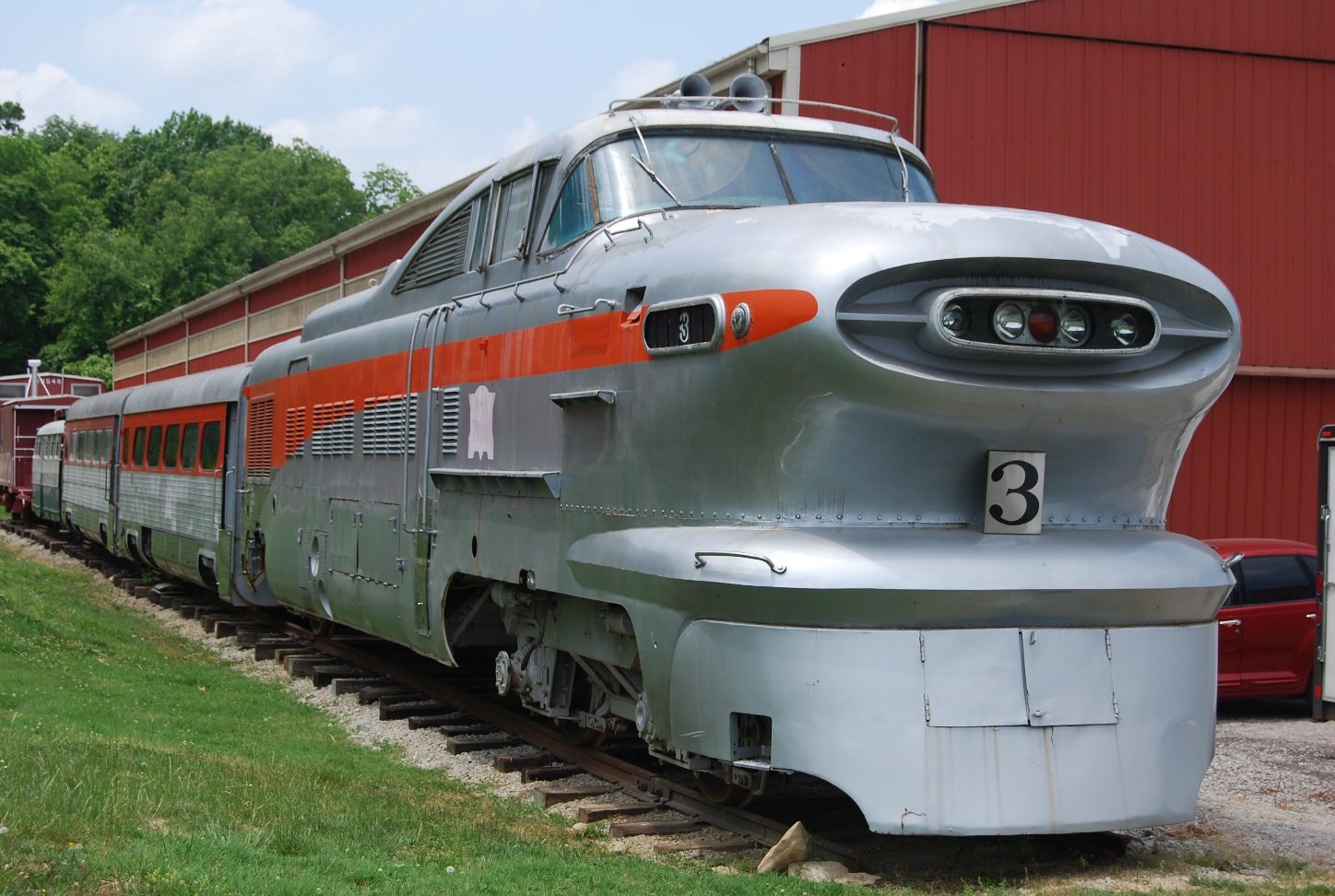

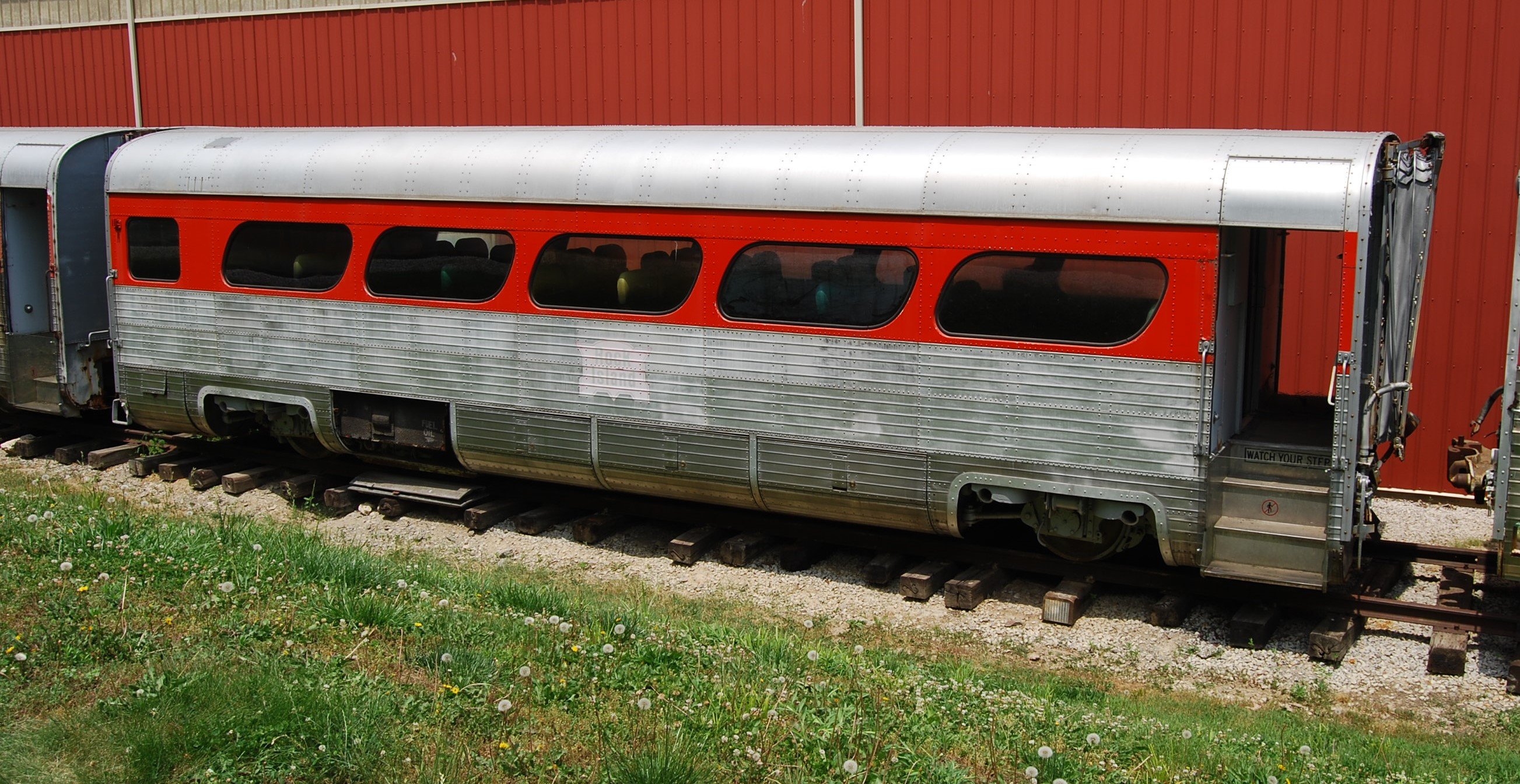

The GM Aerotrain was a prototype trainset which offered a lightweight passenger consist to railroads which were still operating typical heavyweight cars, many of which dated from the 1920s and 1930s. The streamlined body panels and curved glass of the locomotive, combined with the riveted aluminum construction of the passenger cars, used many of the same aesthetics and building techniques that would soon be incorporated into GMs new line of city buses. Indeed, the 40 foot passenger coaches were very much based on the highway coaches of the day and even included air-ride suspension.
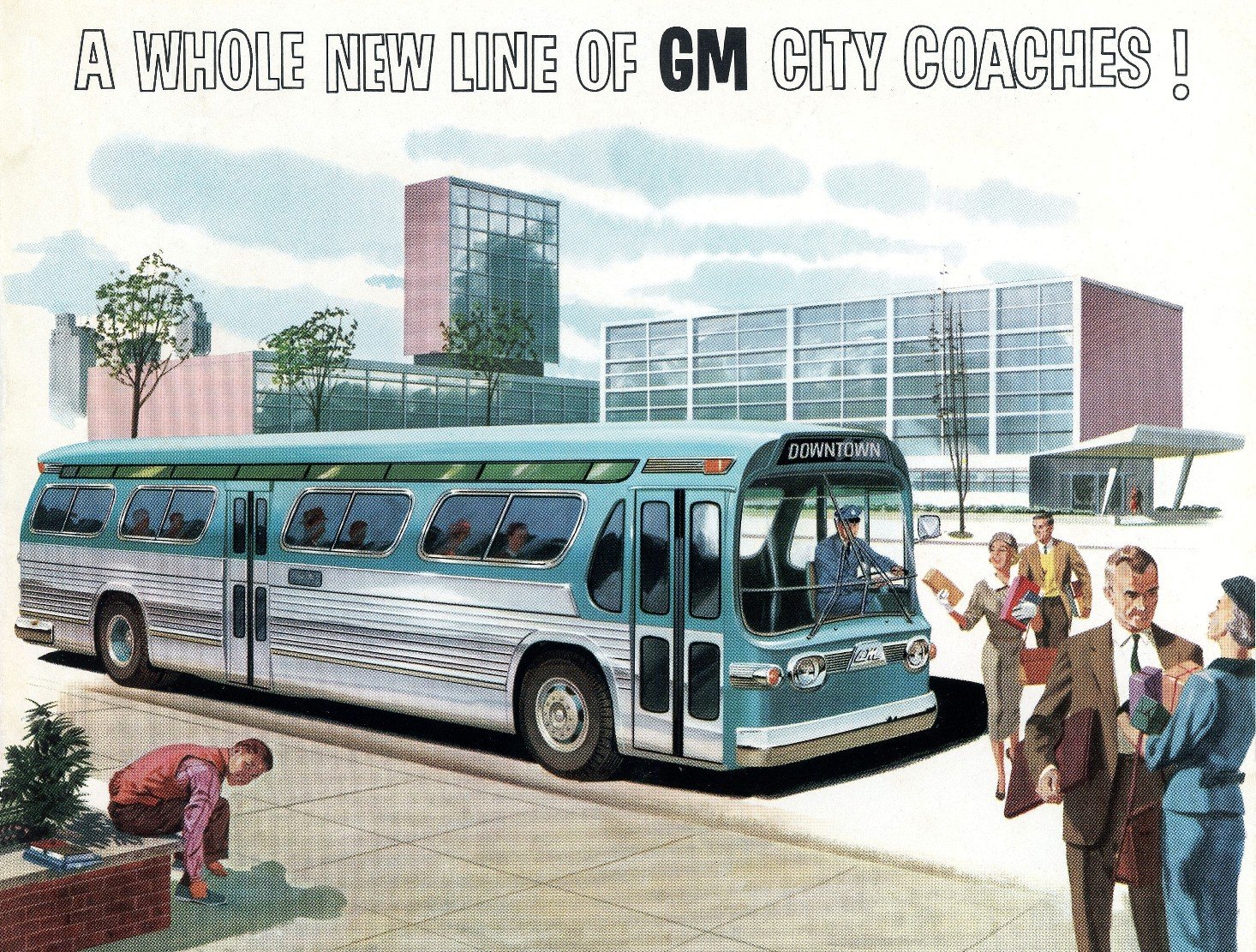

GM sales folder from January 1959 announces the new generation of transit buses which will soon be available. Prototype construction is likely underway by this time but actual production will not begin until September of that year. Careful inspection of the headlights in this illustration shows the single headlamp arrangement as originally proposed.
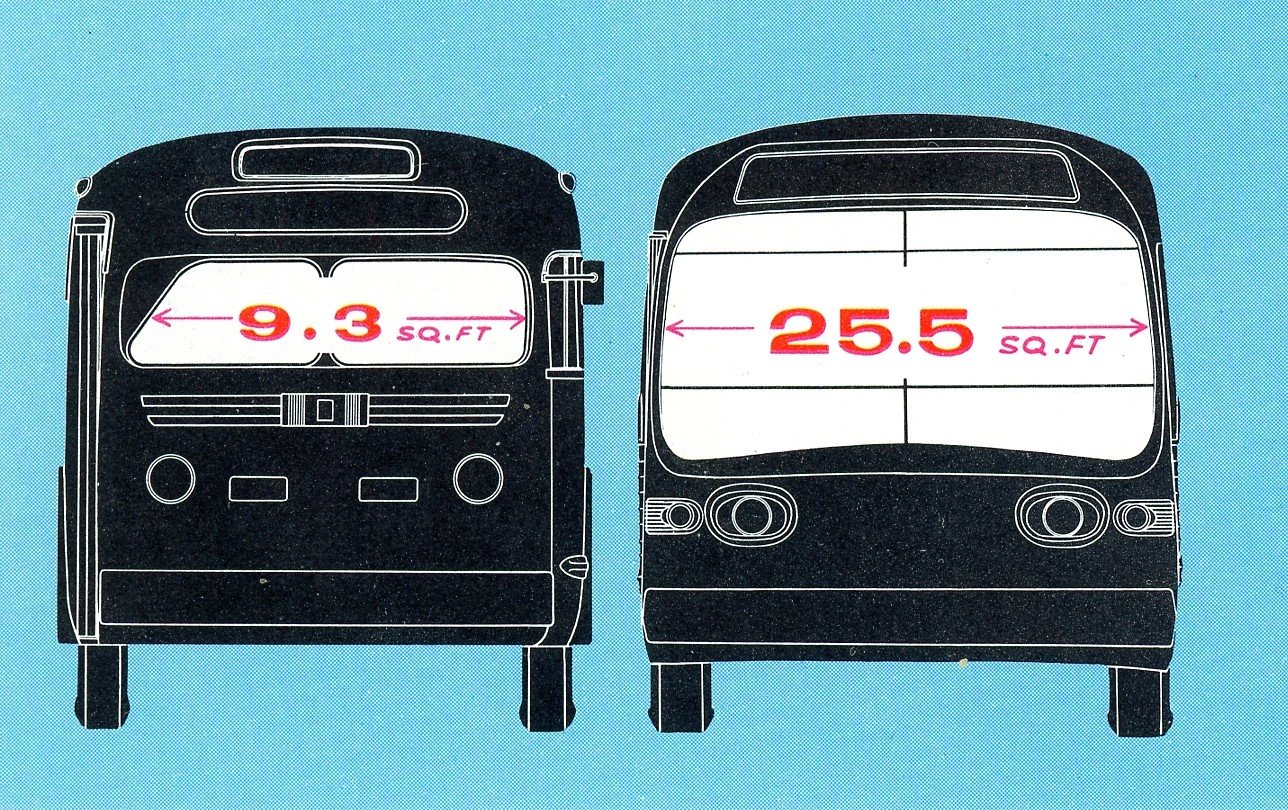

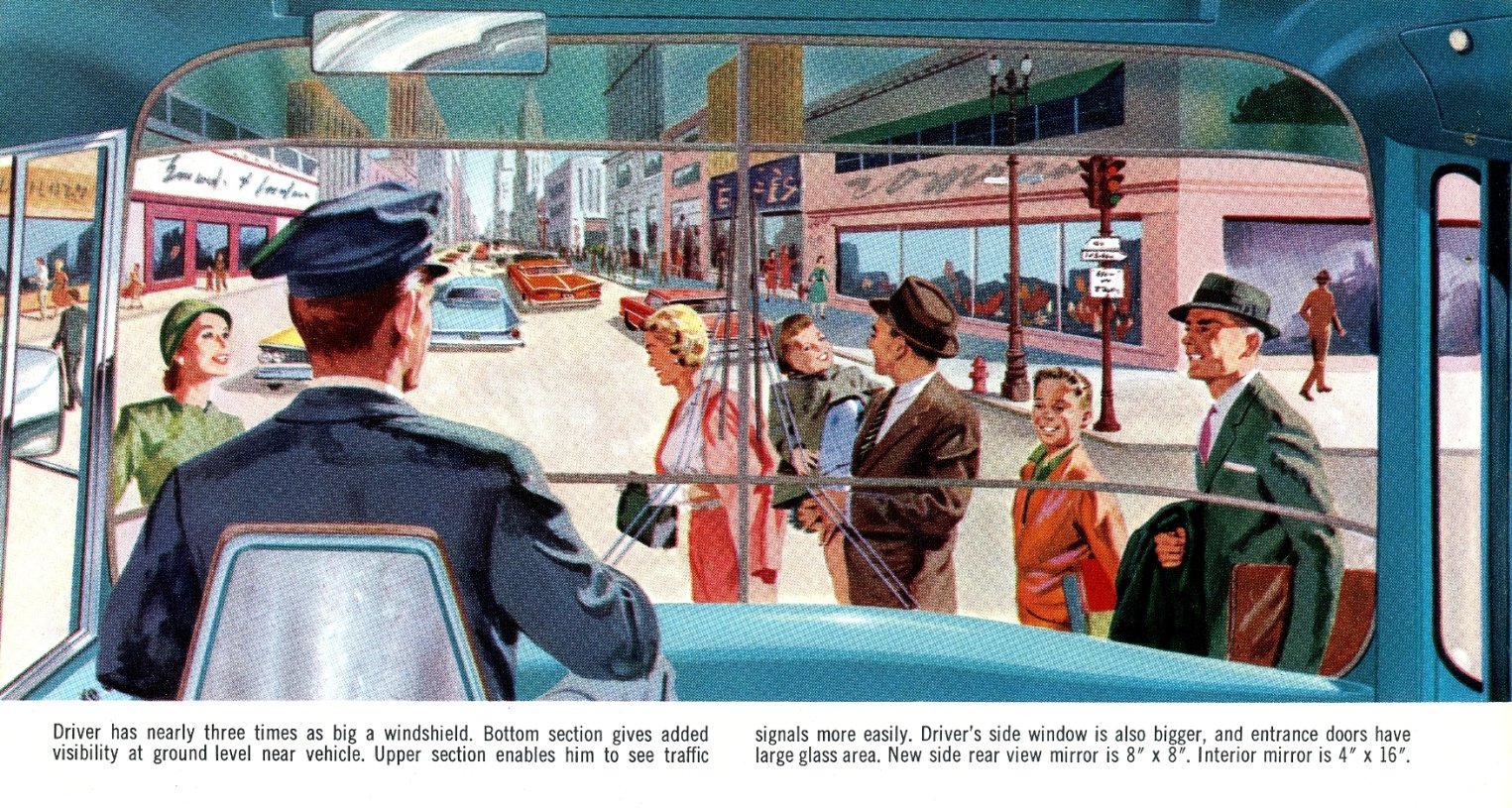

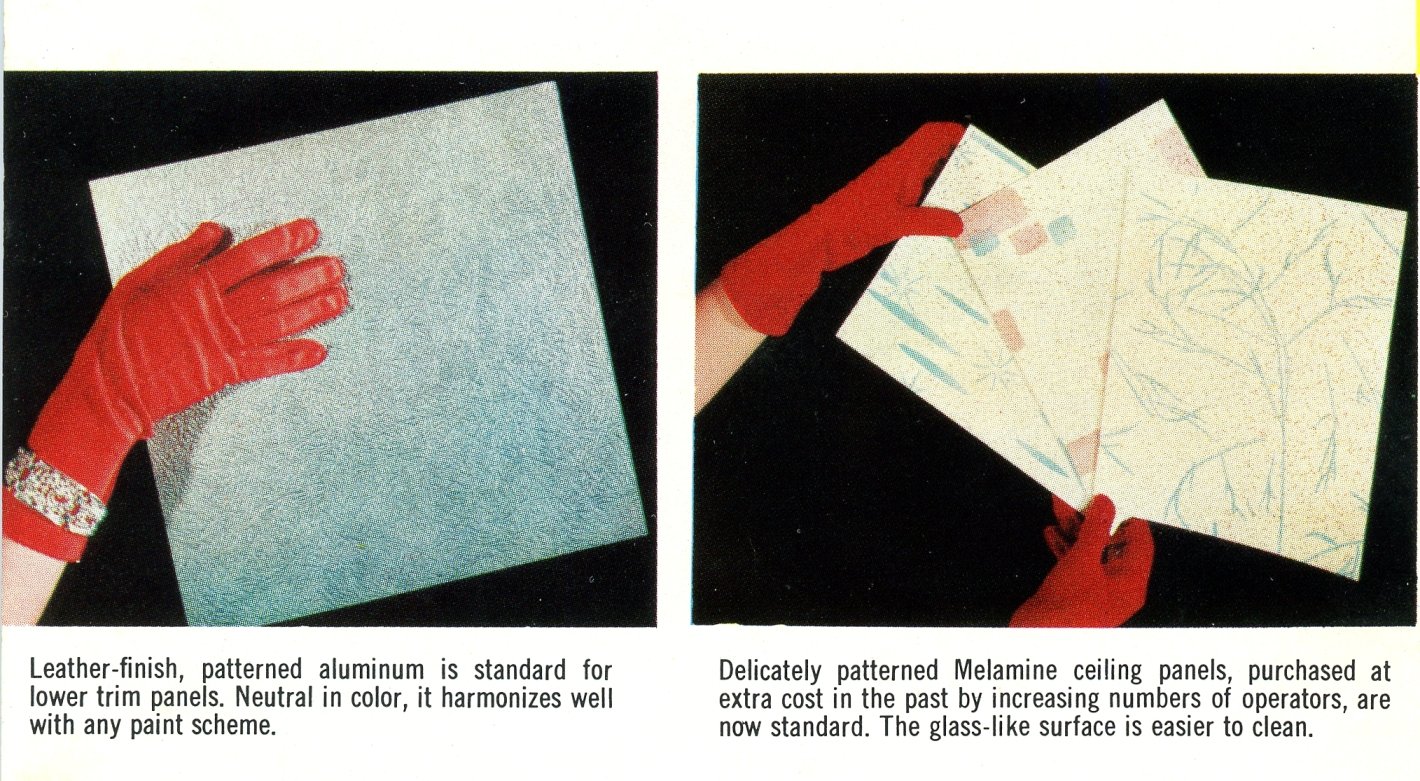

Other features are highlighted in the same sales folder including the enlarged glass area and new brighter interior décor. In 1959, everyone seems to dress sharply – the men all wear hats and the women all have gloves on!
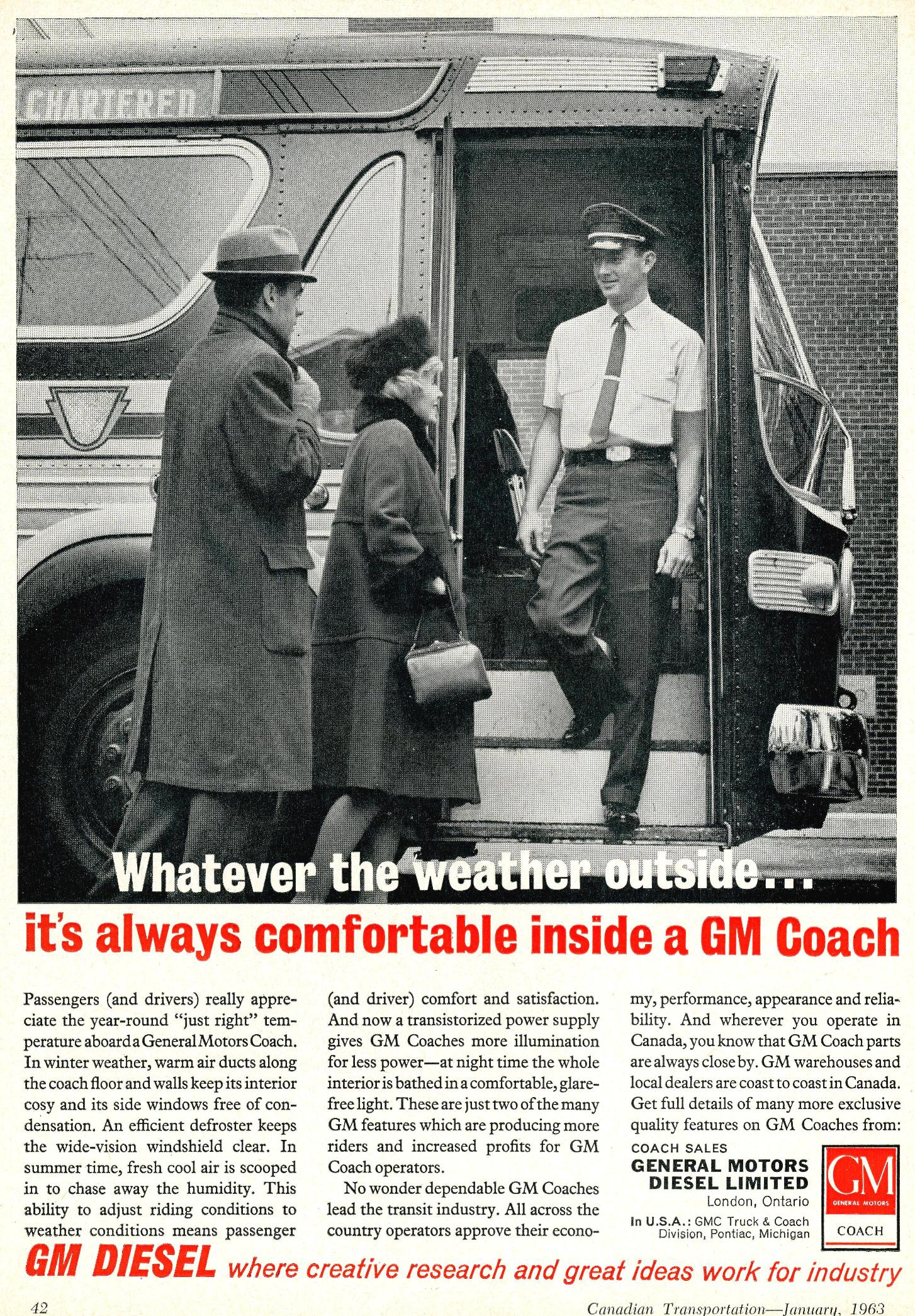

1963 GM Canada advert promoting the New Look warm-wall climate control system, an important feature for Canadian winters.
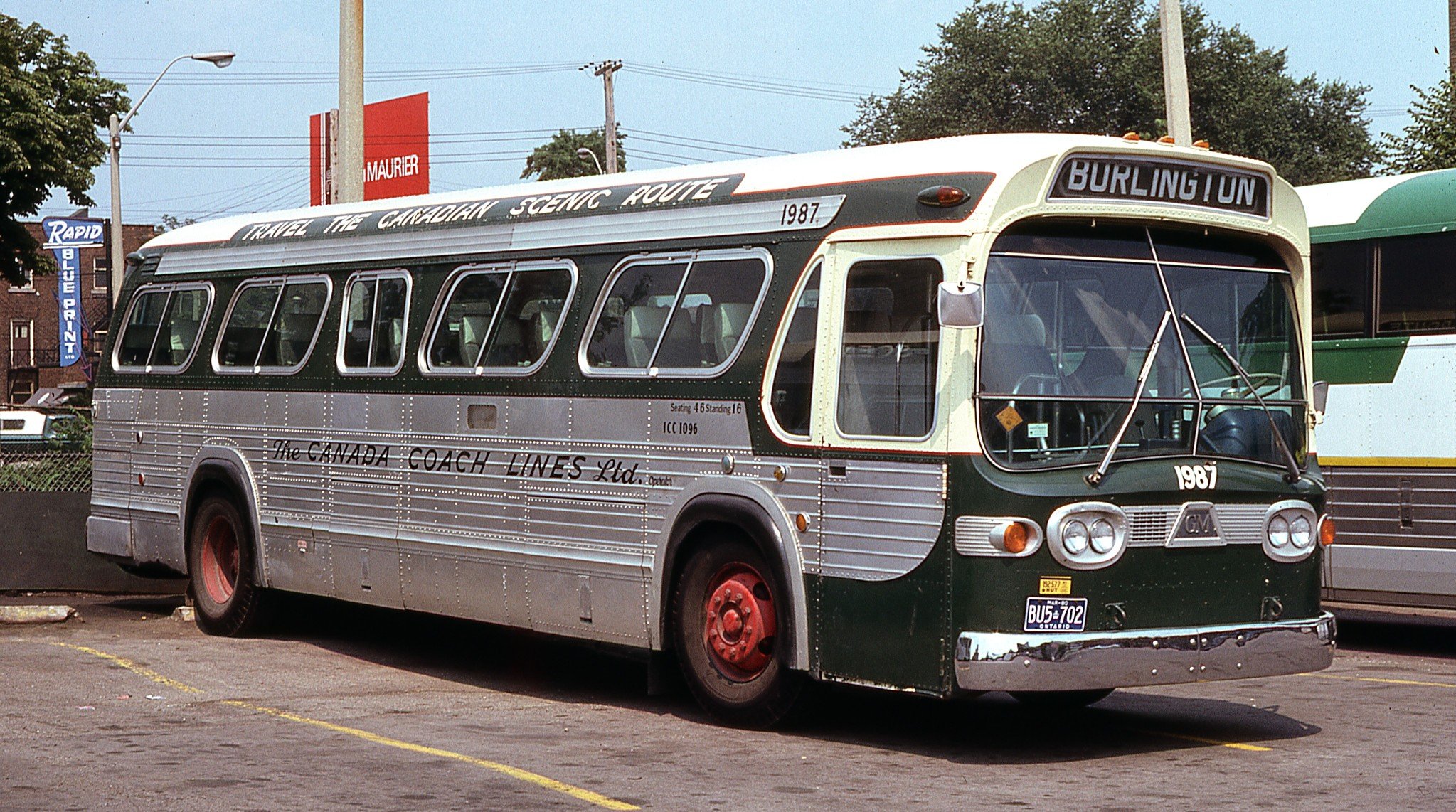

Canada Coach Lines #1987 is shown here in Hamilton Ontario in July 1979. A suburban style New Look, the features include high back seats on raised side platforms, underfloor luggage bays, lack of standee windows and the rare sedan door option. Unknown photographer A.Zhelka Collection
The bus is a SDM-4502 model. GM New Look nomenclature was pretty straightforward and used 7 (later 8) characters to indicate specific models.
S or T signified a Suburban or Transit vehicle.
D meant Diesel which was almost all New Looks. But 13 G (Gas) 30 footers were built in 1969. This space later became a 6 or 8 to signify 6 or 8 cylinder motor.
M signified a manual transmission of which most suburbans were. H here signified Hydraulic which were automatic transmissions.
-
45 referred to maximum seating capacity. Thus the choices were 53 (40 foot bus), 45 (35 foot bus) or 33 (30 foot bus)
02 referred to the specific series of bus which changed for successive generations of New Looks. Thus series numbers ranged from 01 to 23 depending on model type and whether it was an early or late model coach. Not all possible series numbers were assigned.
A or N was added to later model coaches to differentiate between Air conditioned or Non air conditioned buses.
As noted, this suburban bus is a suburban SDM-4502. In later years many 40 foot T6H-5307N transit buses were supplied to Canadian bus operators
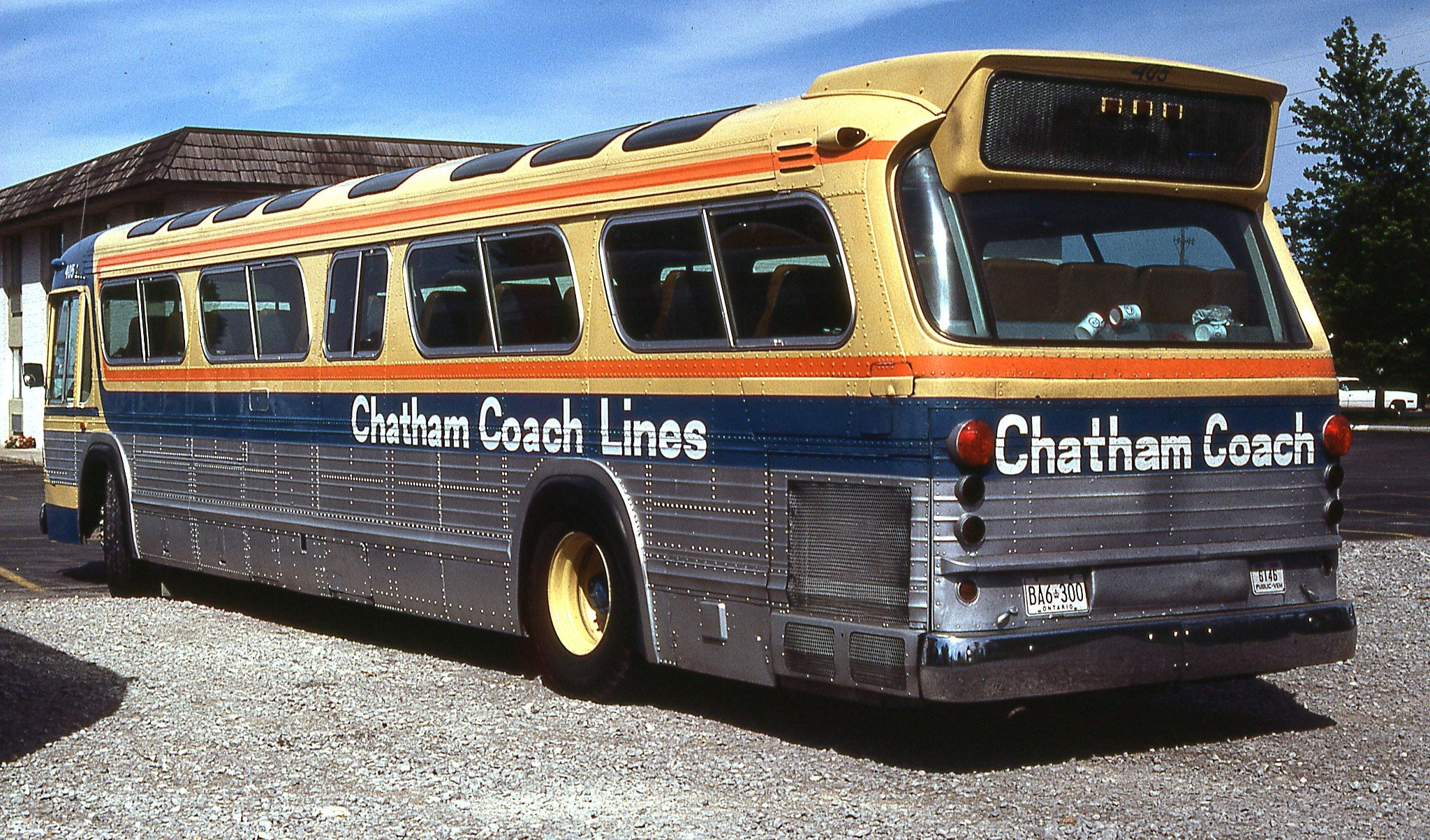

Rear view of another suburban model (Chatham Coach Lines 405 – Chatham, Ontario) shows the the curved rear window and the integration of the air conditioning equipment into the rear roofline. The sightseeing windows in the roofline were also a factory option but in this case, they were retro-fitted some years after delivery to the original owner Gray Coach Lines of Toronto. GM New Looks were often sold off to smaller operators for continued use post initial retirement. Unknown photographer. A.Zhelka Collection
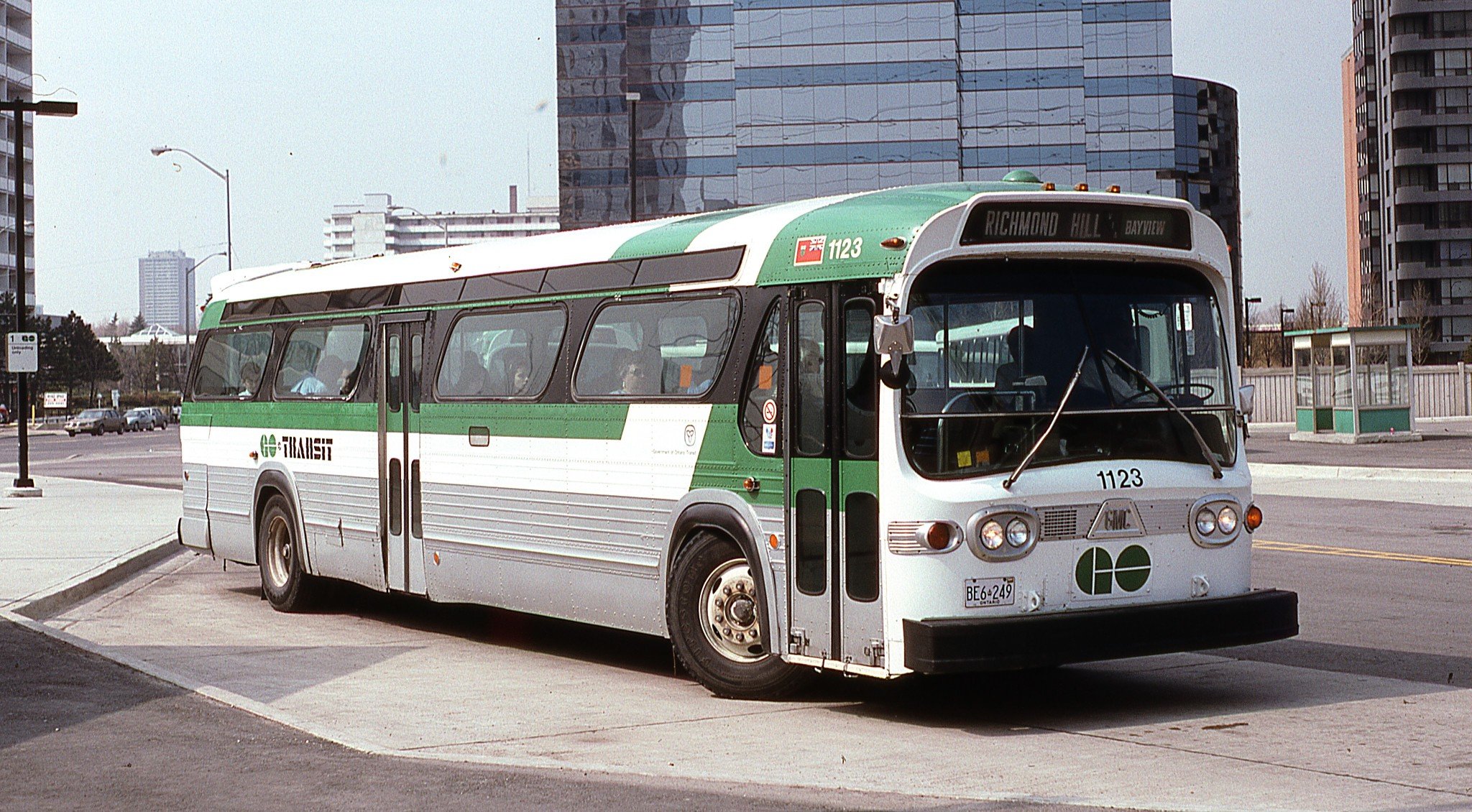

GO Transit #1123, serving communities outside of Toronto, Ontario, is closer to the typical two door transit arrangement but these particular these buses did feature a few buses did have several options which were usually reserved for purely suburban models. These included air conditioning, sealed side windows and high back seats.
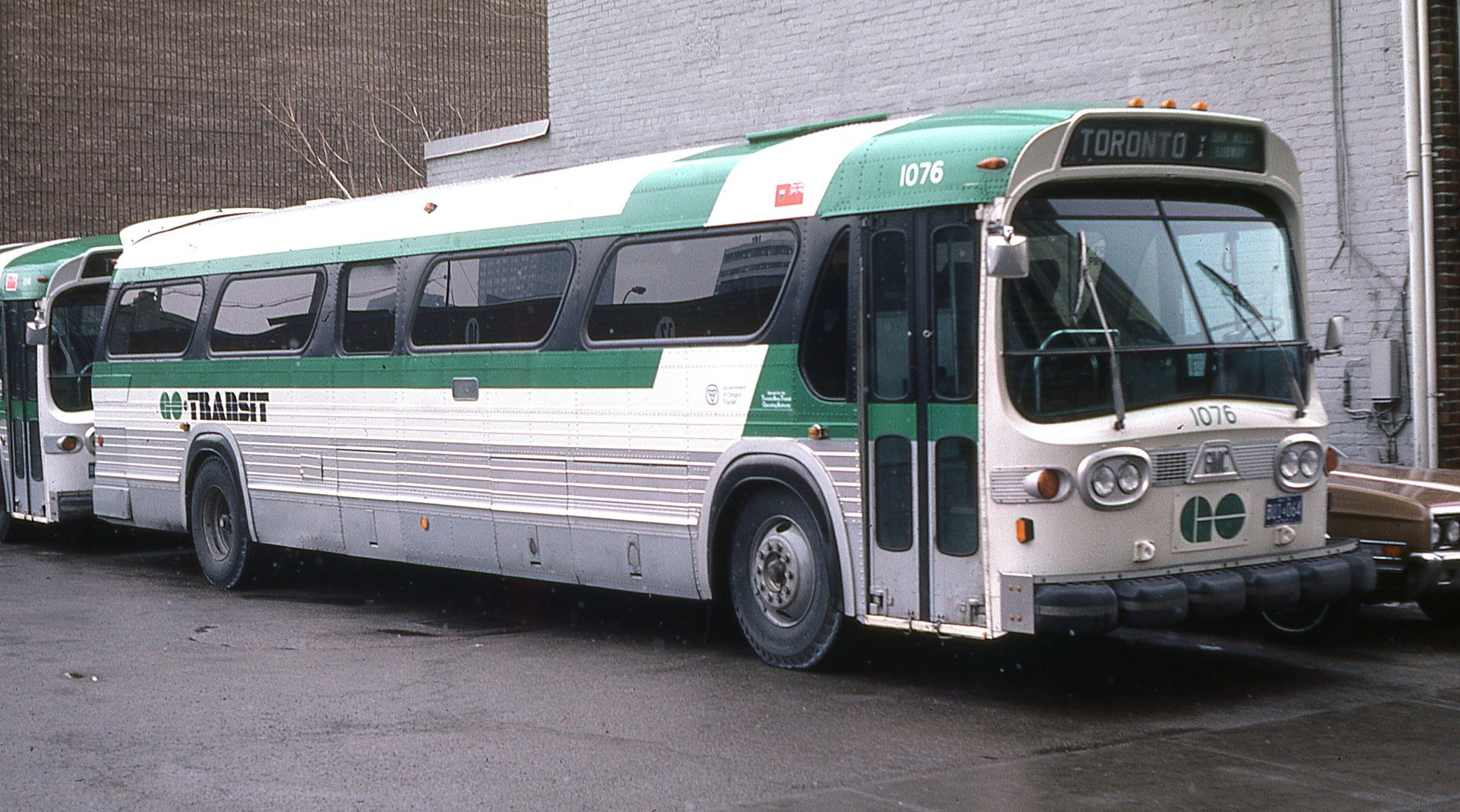

GO Transit #1076 is typical of the suburban New Look with its single door, underfloor luggage bays a/c and sealed side windows.
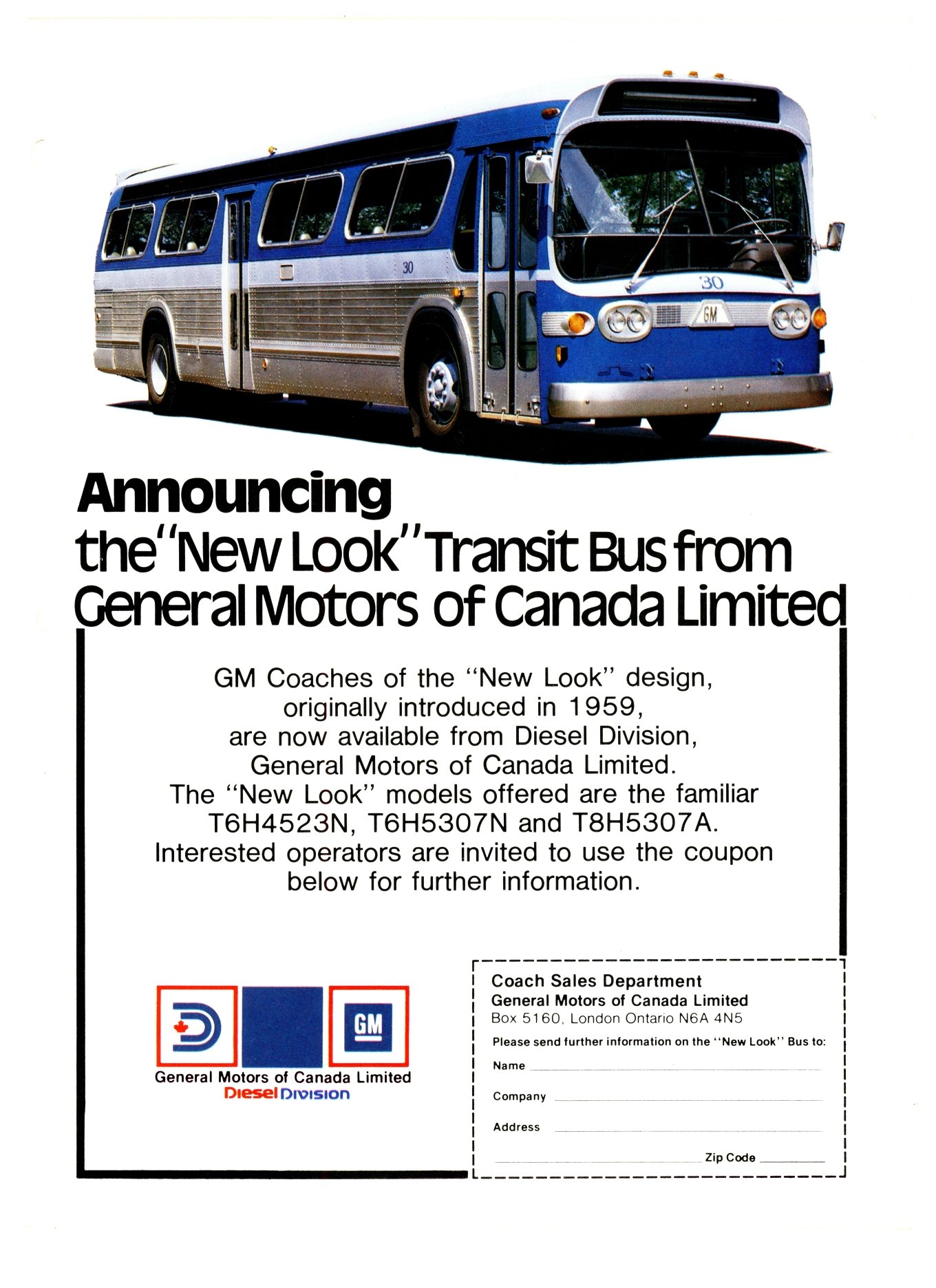

1979 GM Canada advert inviting inquiries for its New Look lineup. By this time, US New Look production has ceased but some of these customers were not sold on the merits of the replacement RTS series and headed north to obtain this familiar and reliable bus.
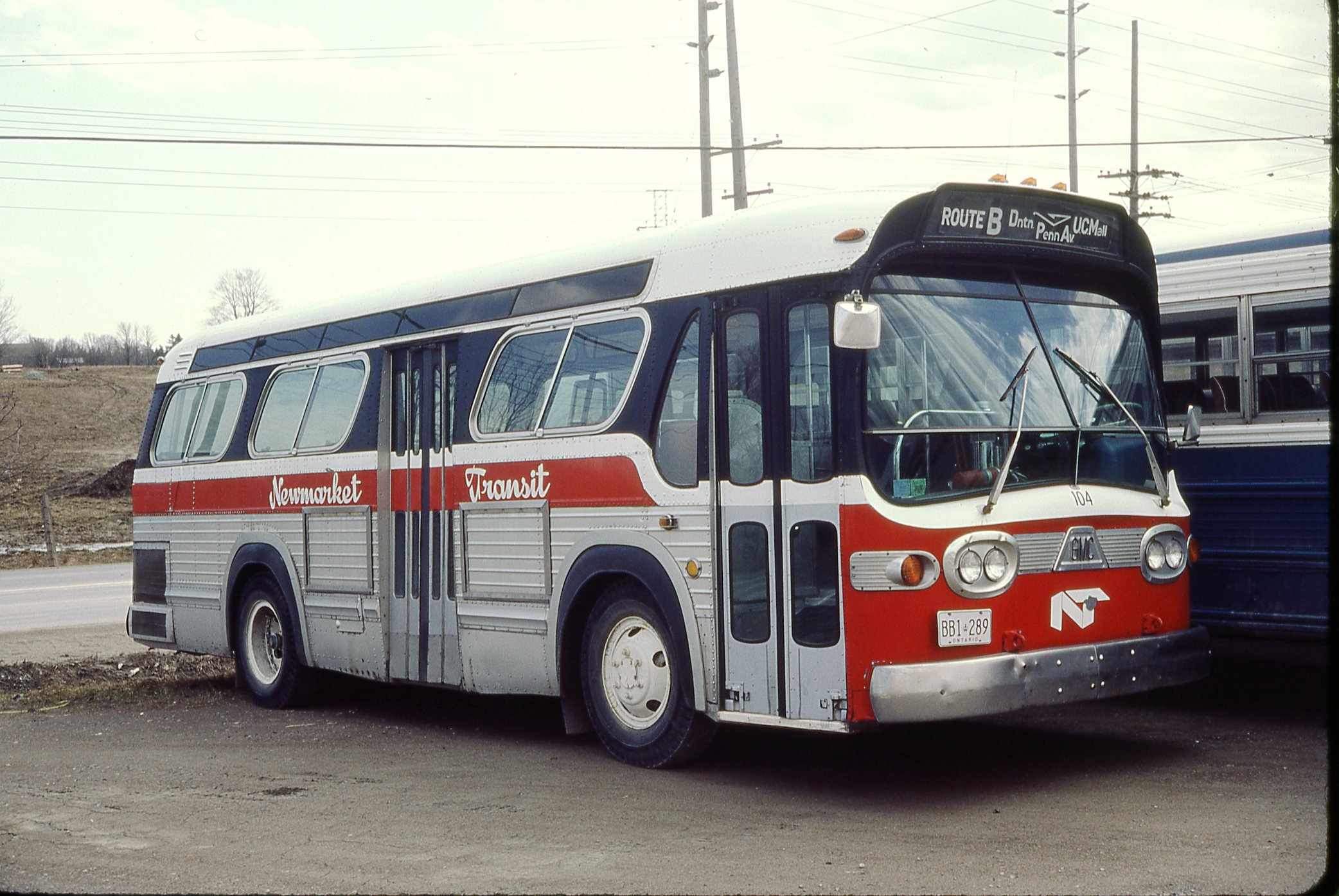

Old Look production still continued until 1969 when GM finally introduced a 30 foot New Look to satisfy the small bus market. These were the 3301 and 3302 models which only received a luke warm reception by the transit industry. They were a curious assembly of a New Look body and non-standard GM truck mechanical components. These made for lighter duty (and presumably a more affordable) bus but often led to reliability issues. A few early models were even built using gasoline motors! They were only offered until 1973 and just over 500 such buses were built.
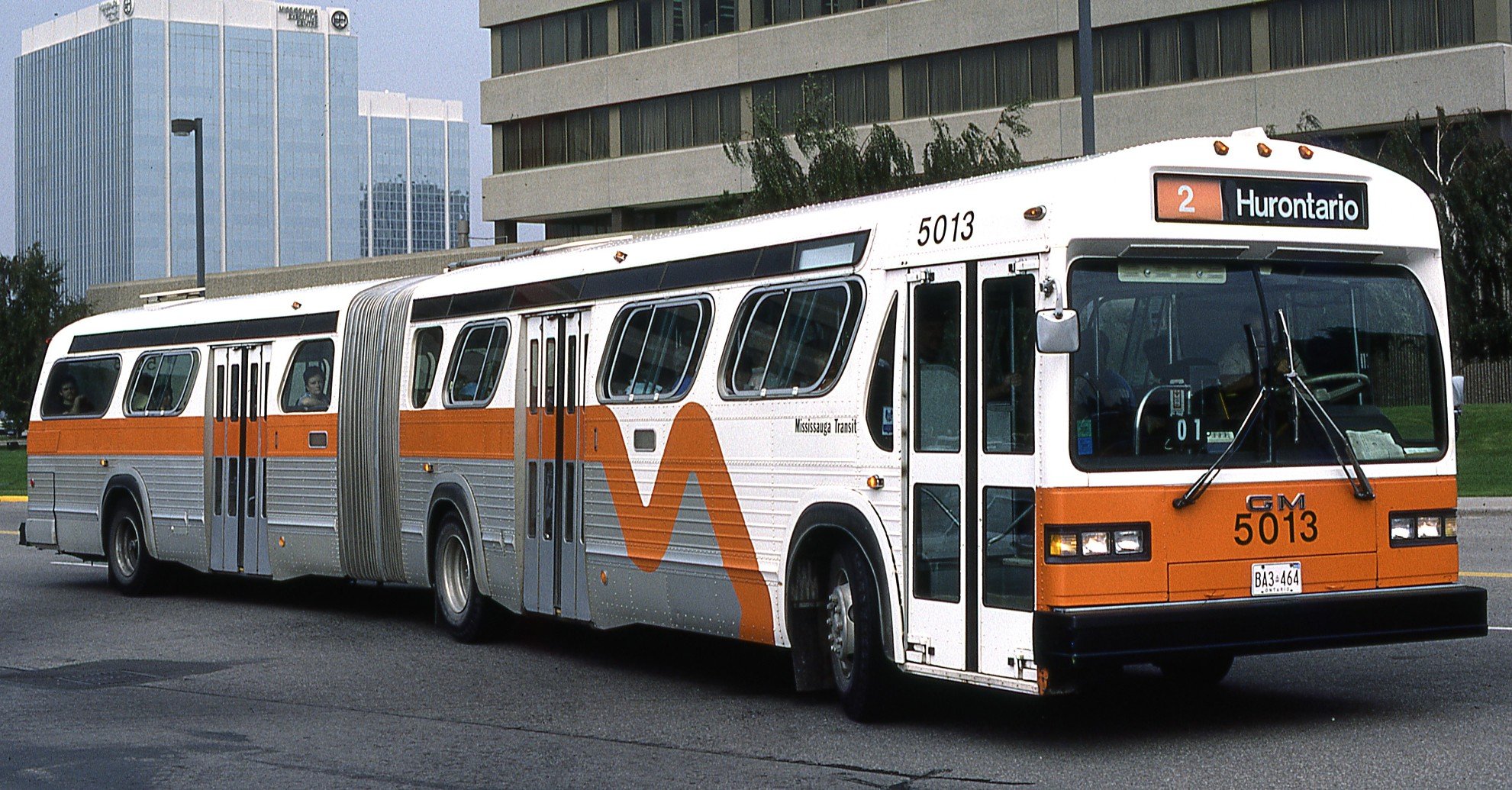

At the other end of the spectrum was this 60 foot GM Canada articulated bus. These were impressive looking buses and by all accounts, they were solid and reliable. Unfortunately, beyond the original 53 bus order, no other units were constructed.
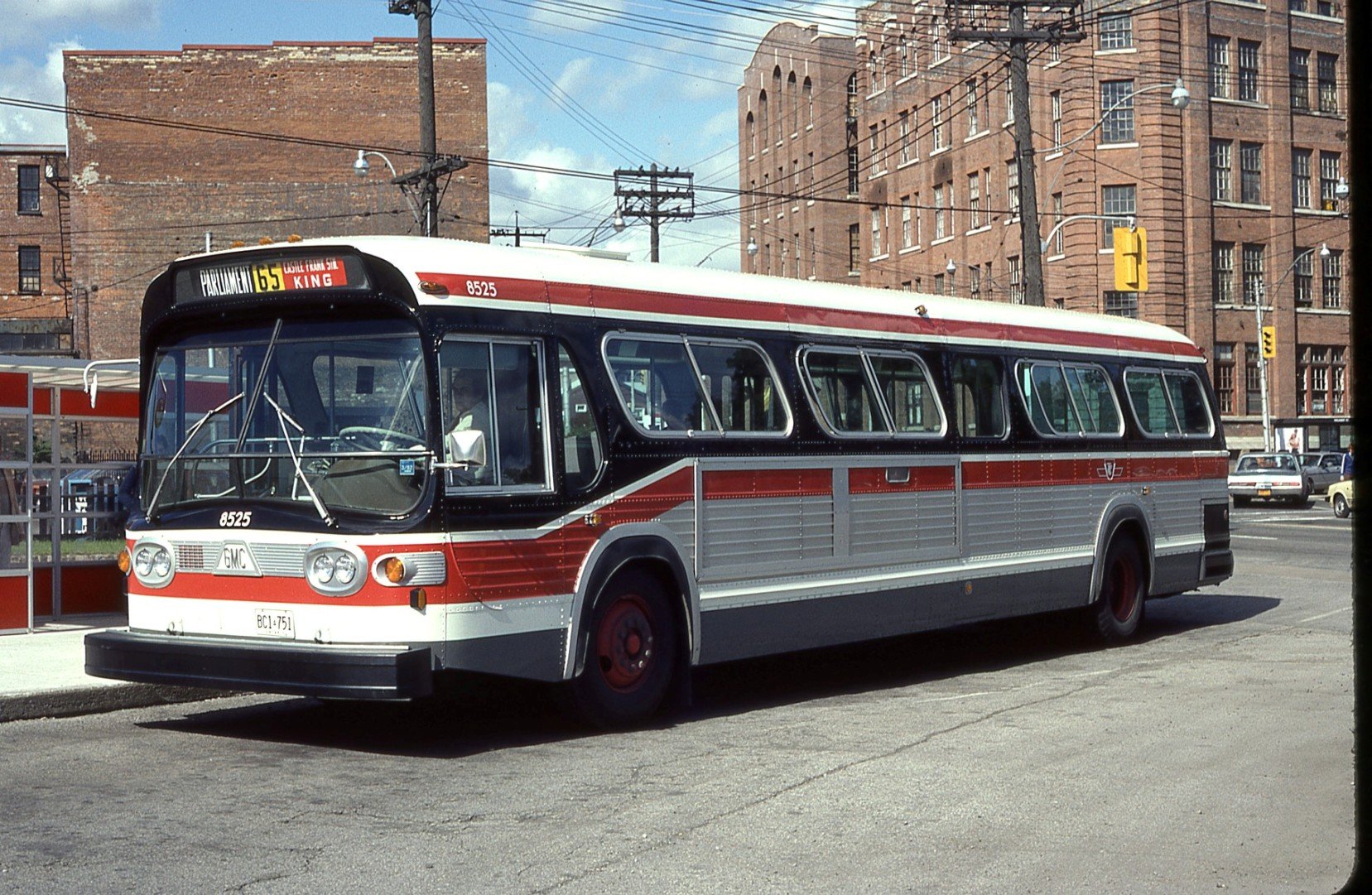

TTC 8525 is typical of the later generation New Look transit buses. These T6H-5307N units were purely transit, and were bought in large numbers by the TTC (and other operators) as New Look production was gradually winding down in favour of the new replacement Classic model. They served the TTC very well and with rebuilding, would remain in base service until the last of them were retired in December 2011.
Adam Zhelka, Toronto



